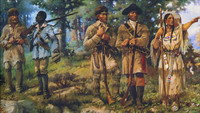Login form
Lewis and Clark Expedition
 In 1804, Lewis and Clark set out to explore the American West. They were seeking a way to travel by water between the Pacific and Atlantic coasts of North America. They crossed 8,000 miles and braved grizzly bears, gray wolves, steep mountain passes, and harsh winter weather to explore a vast wilderness. Along the way they met many native peoples and made important discoveries.
In 1804, Lewis and Clark set out to explore the American West. They were seeking a way to travel by water between the Pacific and Atlantic coasts of North America. They crossed 8,000 miles and braved grizzly bears, gray wolves, steep mountain passes, and harsh winter weather to explore a vast wilderness. Along the way they met many native peoples and made important discoveries.
NORTHWEST PASSAGE
This epic journey was United States president Thomas Jefferson’s idea. He wanted to claim control of the western part of North America before rival nations from Europe staked their claims.
He also wanted to explore the area’s natural resources. He believed that there must be a route across America by water, along its rivers and lakes or around its northern shore. He hoped this “Northwest Passage” could carry ships, soldiers, and settlers to the heart of the West and to the Pacific Ocean.
CORPS OF DISCOVERY
Jefferson chose two young army officers, Meriwether Lewis and William Clark, to find this hoped-for waterway. Lewis and Clark set out from St. Louis, Missouri, in May 1804. Their team, known as the “Corps of Discovery,” consisted of 48 men. The men included Clark’s African American slave, named York, and some Frenchmen experienced in boating on the Missouri River. Many U.S. soldiers, huntsmen, and adventurers were also part of the group.
SACAGAWEA
In 1805, a woman of the native Shoshone people, Sacagawea, joined the expedition. She became the expedition’s chief interpreter. She explained the peaceful purpose of the explorers when they met native peoples. She also helped bargain for horses and food. To Lewis and Clark, the West was strange, new, and sometimes threatening. They would not have survived without the information provided by the native peoples about nearby areas.
A TOUGH TRIP
Lewis and Clark planned to follow the Missouri River to its source, cross the Rocky Mountains, then look for waterways flowing west towards the coast. But they had no knowledge of western geography, and no experience with the harsh western environment. As the explorers headed west, paddling wooden canoes, they found their way blocked by rocks, rapids, and huge waterfalls. In the mountains they got stuck in snowdrifts. Pouring rain kept them soaking wet for months at a time.
Slowly, they made their way north and west. In November 1805, after about a year and a half of travel, they finally reached the Pacific Ocean. The place where they stood to look out over the ocean is near present-day Astoria, Oregon. It took another year to return to base camp at St. Louis. On the way back the expedition explored the mighty Yellowstone River.
NO WATERWAY
Everywhere the explorers traveled, they saw fascinating things. Lewis and Clark kept journals to record their discoveries. They found 298 types of plants and animals that were previously unknown. They made maps charting the courses of rivers and sketched magnificent mountain scenery. They detailed the hardships they endured, and described native peoples’ traditional ways of life. Try as they might, however, they found no trace of a Northwest Passage. There was no way to cross North America by water. But their expedition was not a failure.
A NEW VIEW OF AMERICA
When Lewis and Clark returned, President Jefferson was disappointed that they had not discovered a Northwest Passage. But he soon realized that the expedition had been a remarkable success. They made the first scientific study of a vast territory and strengthened U.S. claims to western lands. They made friendly contact with several groups of native inhabitants. They gathered enormous amounts of information. Above all, their expedition revealed the astonishing richness and beauty of the American West.
Source: Microsoft ® Encarta

